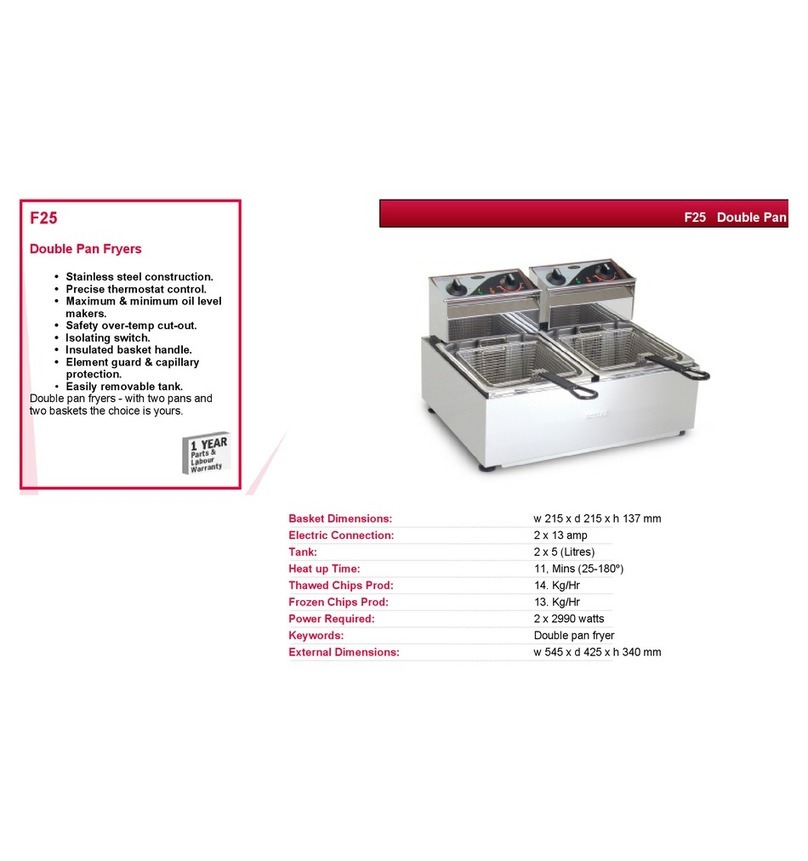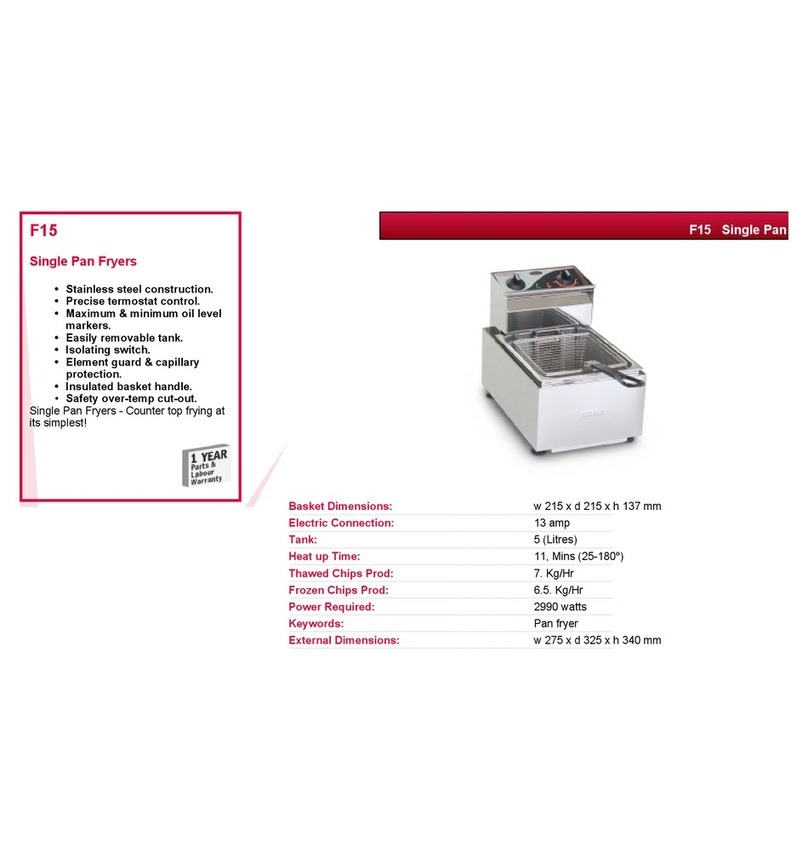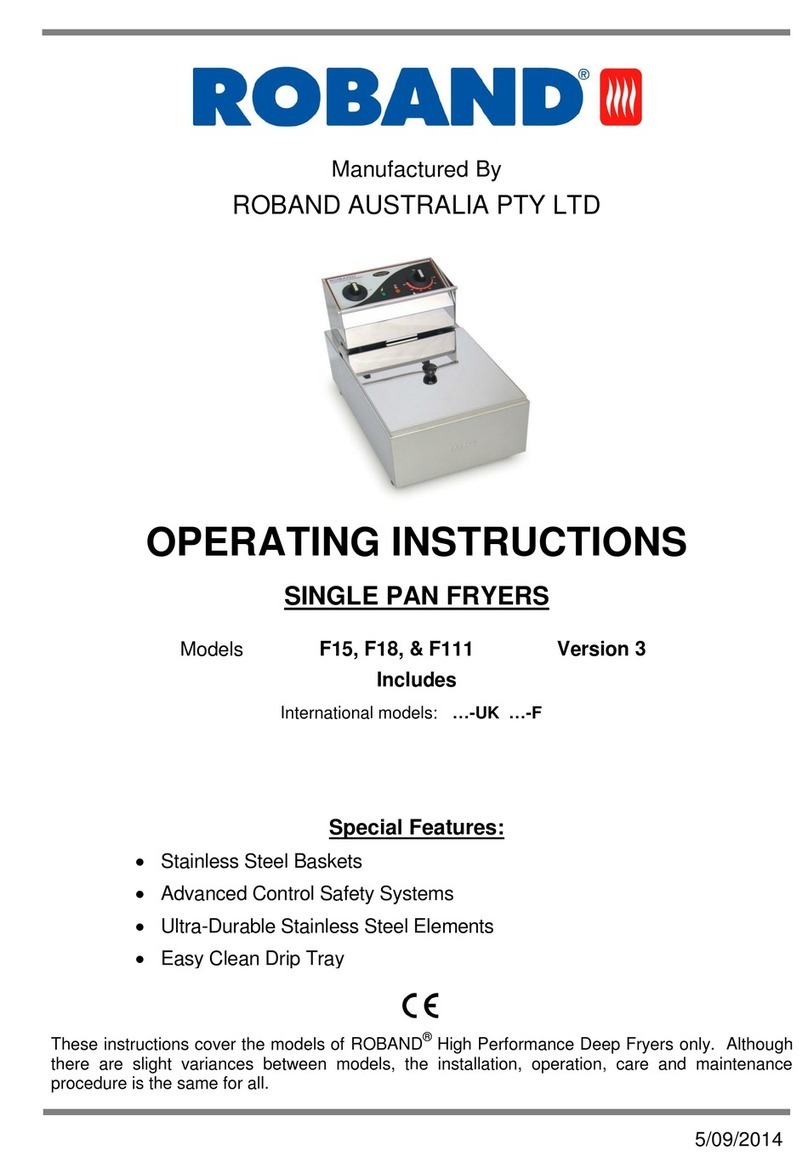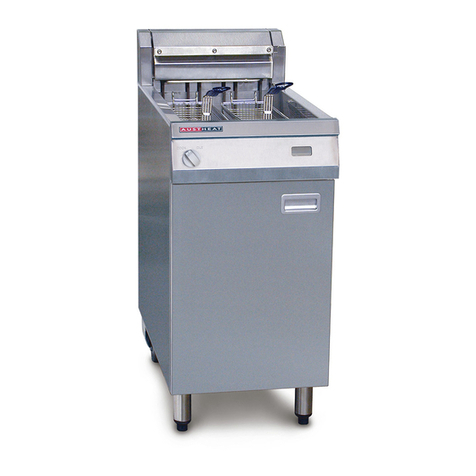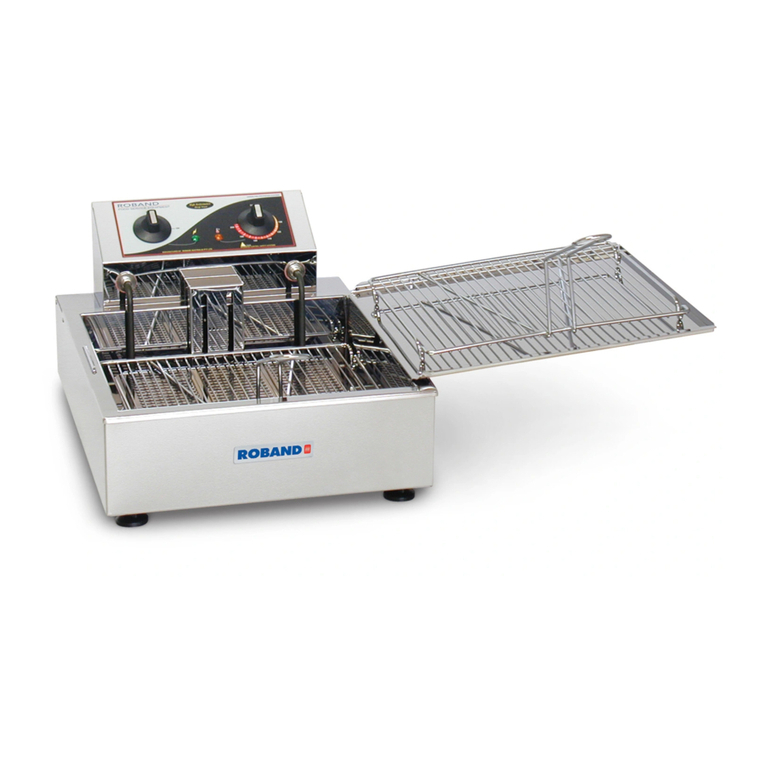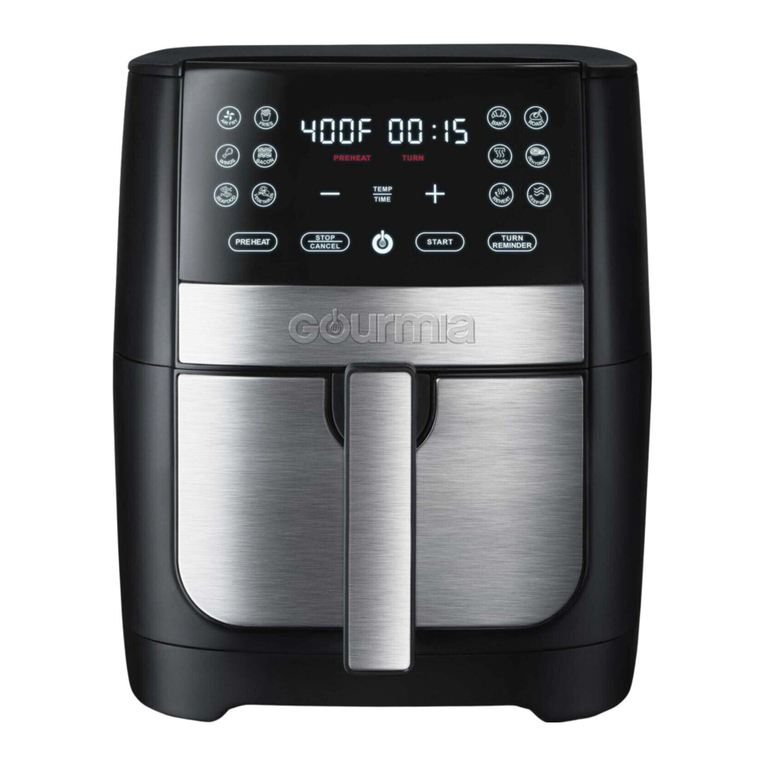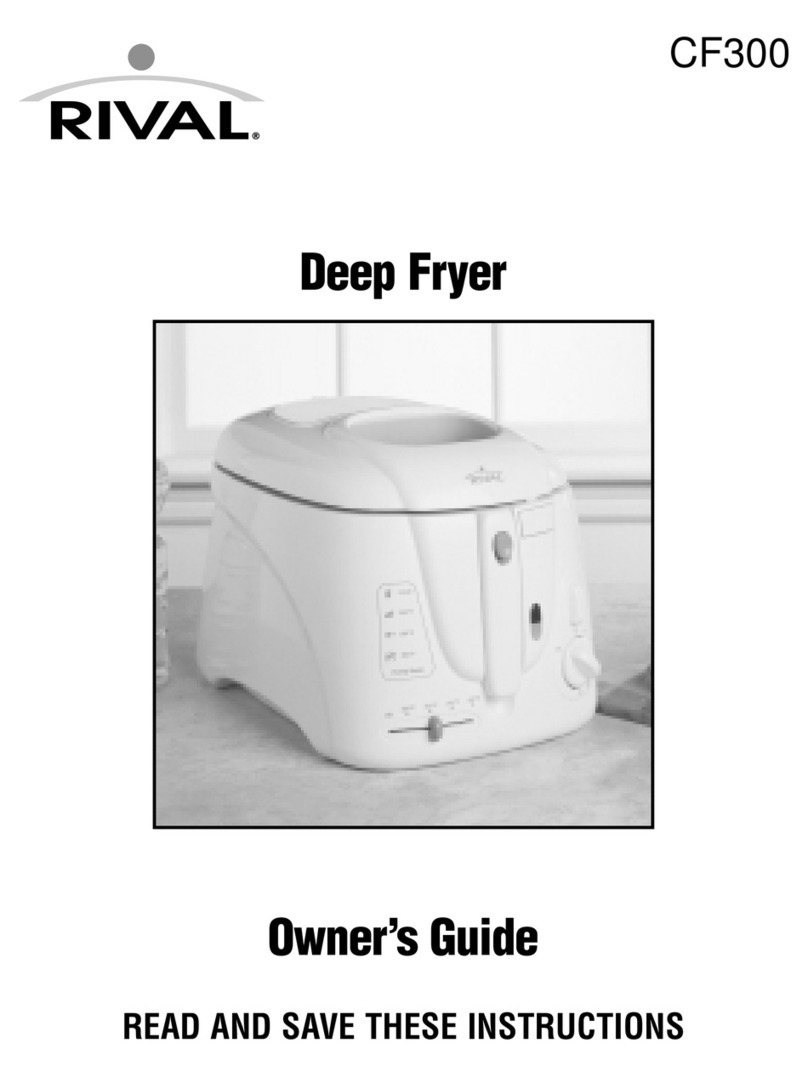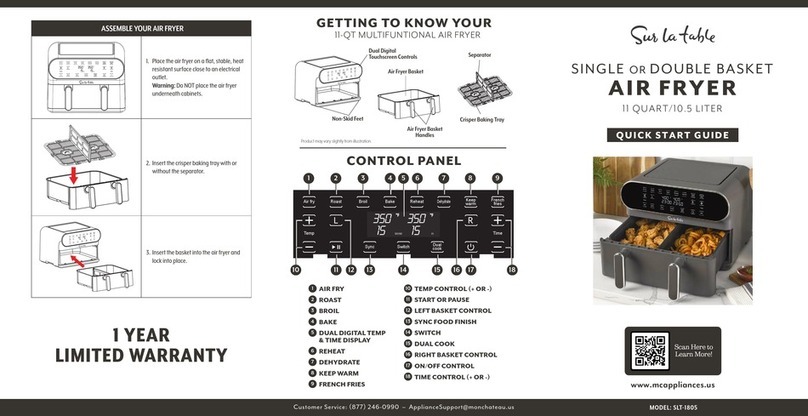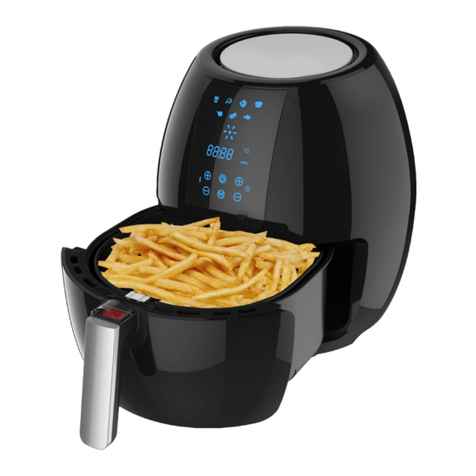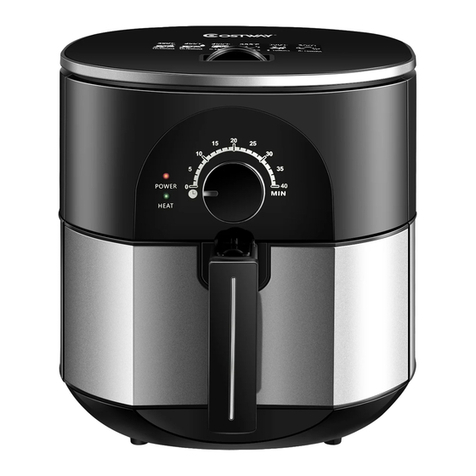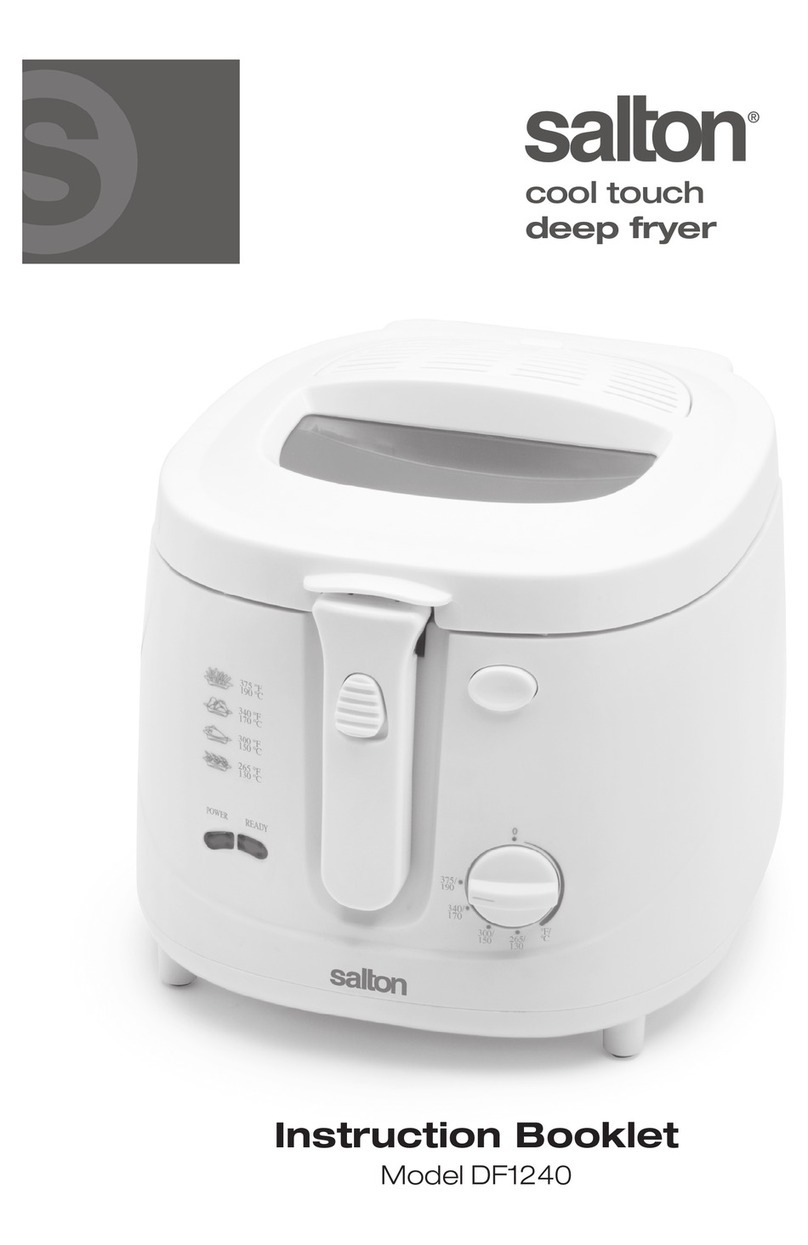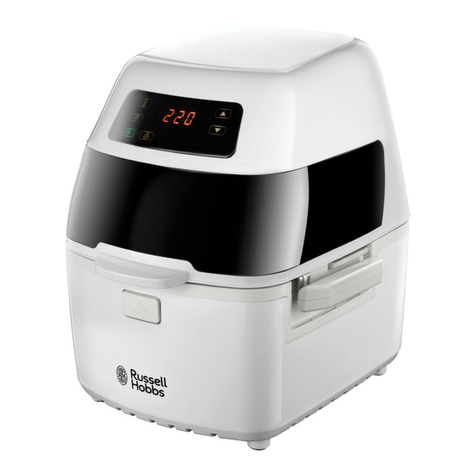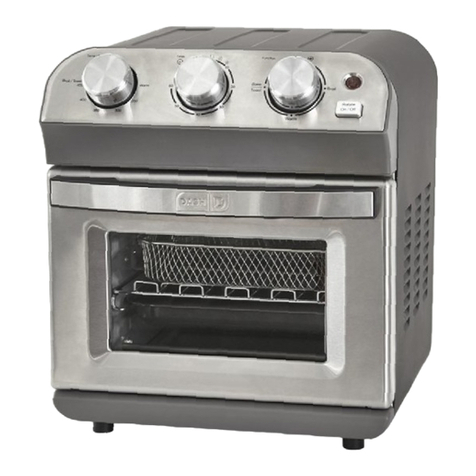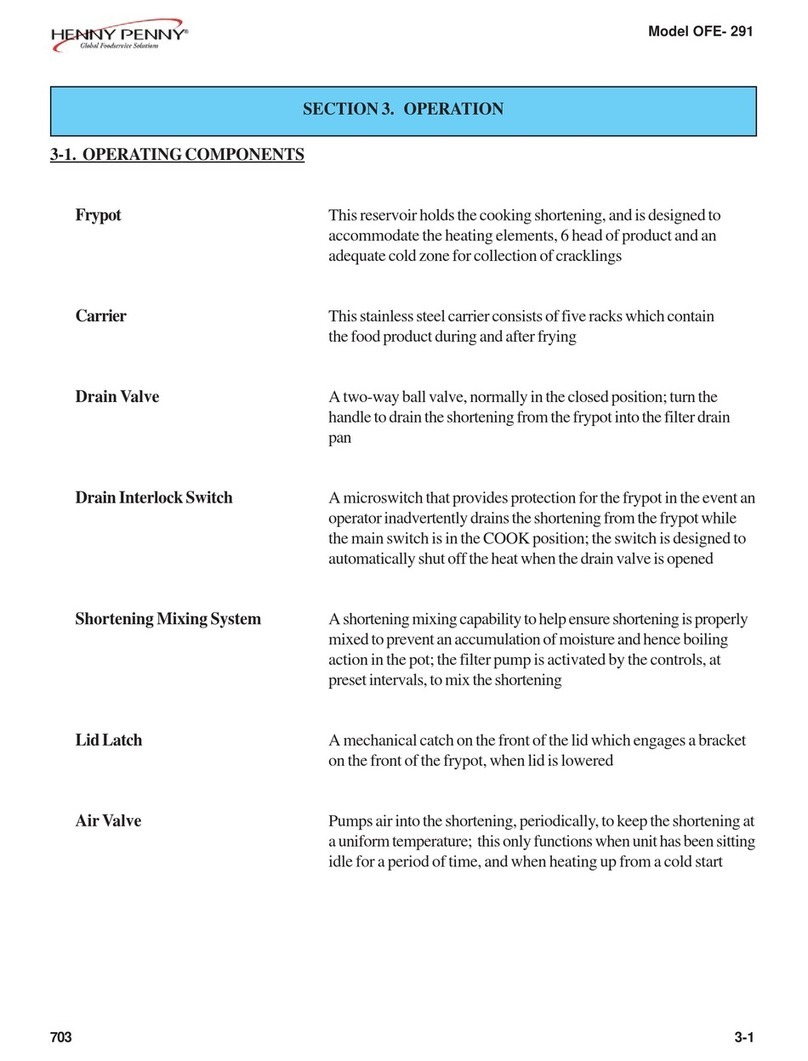ROBAND F25E User manual

MANUFACTURED BY
ROBAND AUSTRALIA PTY LTD
OPERATING INSTRUCTIONS
DOUBLE PAN FRYERS
MODELS: F25, F25E, F28, & F28E.
Version 3
F25-UK
Version 1
Special Features:
Safety Over-Temperature Cutout as Standard
Advanced Control Safety Systems
Ultra-Durable Stainless Steel Elements
Superior Reliability & Longevity
These instructions cover the models of ROBAND®Double Pan Fryers
listed above. Although there are slight variances between models, the
installation, operation, care and maintenance procedure is the same for
all.

Page 2
Roband®
Roband Australia is a wholly Australian owned company and has been
manufacturing quality commercial catering equipment for the food service
industry for more than 50 years. Roband products are engineered and
manufactured to the highest standards to provide functionality, reliability
and durability, and our quality products are exported world-wide.
Included in the comprehensive ROBAND®range are Toasters, Fryers,
Milkshake Mixers, Rotisseries, Food Display Cabinets and much more.
Roband Australia also acts as the Australian agents for Vitamix®Blenders,
NOAW®Meat Slicers, RYNO Stainless Benching, RobalecTM Soup/Rice
warmers and Dito Food Processors.
In addition to a vast range of machines, Roband Australia has its own line
of commercial cookware and cutlery under the Robinox®brand name.
For a complete set of brochures please contact your nearest authorised
dealer or contact Roband directly at our head office.
Roband Australia Pty Ltd
11 Inman Road
DEE WHY
NSW 2099
Australia
Telephone: 61 – 2 – 9971 1788
Facsimile: 61 – 2 – 9971 1336
E-mail: [email protected]
Website: www.roband.com.au
For additional Agents in other
Countries please email Roband
Head office.
© Copyright 2000 – Roband Australia Pty Ltd
All rights reserved. No part of this work may be reproduced or copied in any form or by any means,
electronic or mechanical, including photocopying or posting to a website, without the written permission of
the publisher. The material contained within this document is intended entirely for instructional purposes.
International Agents
Canada: Lessard Agencies
Ph +1 416 766 2764
Europe: Valera Ltd, (UK) 0845 270 4321
Fiji: Hotel Equipment
Ph +679 672 0666
Hong Kong: Chung Wah
Ph +852 2334 5411
New Zealand: Roband New Zealand
Ph +649 274 1354
Papua New Guinea: Brian Bell
Ph +675 325 5411
Saudi Arabia: A S Al Jared Establishment
Ph +996 2 6451 451
Singapore: Jelco Private Ltd
Ph +65 5611 988
Thailand: Seven Five Distributors
Ph +662 866 5869

Page 3
CONTENTS
INTRODUCTION...........................................................................4
GENERAL PRECAUTIONS..........................................................4
PACKAGING.................................................................................5
COMPLIANCE ..............................................................................5
C-Tick:................................................................................................... 5
CE:........................................................................................................ 5
ACSS (Advance Control Safety System): ............................................. 5
INSTALLATION............................................................................6
OPERATION.................................................................................8
GENERAL SAFETY....................................................................10
SAFETY FEATURES.......................................................................... 10
GENERAL FIRE SAFETY................................................................... 10
CLEANING, CARE & MAINTENANCE ......................................11
TROUBLESHOOTING................................................................12
CIRCUIT DIAGRAM*.............................................................................. 13
Models F25, F25E, F28, F28E............................................................ 13
SPECIFICATIONS ......................................................................14
EXPLODED DIAGRAM ..............................................................15
F25...................................................................................................... 15
F28...................................................................................................... 16
NOTES........................................................................................17
Tips for Healthy Frying........................................................................... 18
TIPS ON DEEP FRYING CHIPS.................................................19
APPENDIX A...............................................................................21
Residual Current Devices (RCD’s)...................................................... 21
EC DECLARATION OF CONFORMITY.....................................22
Warranty ..................... 23

Page 4
INTRODUCTION
Congratulations on your purchase of this quality ROBAND®product. With
proper care and management your new purchase will give you years of
trouble free service.
By reading these instructions carefully you can ensure that this machine is
used and maintained properly, helping your new investment to perform well
for you now, and to continue performing in the many years to come.
GENERAL PRECAUTIONS
This machine must only be operated by qualified person(s) who are fully
versed in the operating and safety instructions described in this manual.
Servicepersons should be instructed to familiarise themselves with any and
all safety instructions described in this manual prior to commencement of any
maintenance or service.
In the case of new personnel, training is to be provided in advance. These
machines should not be operated by persons (including children) with
reduced physical, sensory or mental capabilities, or lack of experience or
knowledge, unless they have been given supervision or instruction
concerning the safe use of the appliance by a person responsible for their
safety.
These machines are heating units, and as with any commercial heating unit
the surfaces on these Fryers will get hot. Always be careful when near an
operating fryer, and ensure that any risk to unwary customers or staff is
minimised with additional signage if necessary. Due to the obvious heat
hazard Roband recommends that these units be kept out of reach of
children.
These Fryers are for use with oil. The machines are not designed for use
with water for such task as cooking pasta, and any such misuse will void
the warranty.
The machine should be disconnected from all power and allowed to cool
before cleaning.
Roband will accept no liability if;
♦ Non-authorised personnel have tampered with the machine.
♦ The instructions in this manual have not been followed correctly.
♦ Non-original spare parts are used.
♦ The machine is not cleaned correctly, with the right product.
♦ There is any damage to the unit.

Page 5
PACKAGING
All care is taken when packing and Roband ensures that every unit is
functional and undamaged at the time of packaging.
The Package of these Fryers should include:
1) One Fryer (appropriate model)
2) Two Control Boxes (appropriate types)
3) Two Fryer Baskets
4) This manual
5) Packaging materials
Any damage to the machine as a result of freight must be reported to the
Freight Company and to the agent responsible for the dispatch of said unit
within three (3) days of receipt. No claims will be accepted or entertained
after this period.
COMPLIANCE
C-Tick:
Roband®products have been designed and manufactured to comply with
any and all specifications set out by the Australian Communications
Authority (ACA) in regards to Electromagnetic Compatibility. As testament
to such compliance these units bear the C-Tick symbol.
For further information contact the Australian Communications Authority, PO
Box 13112, Law Courts, Melbourne VIC 8010.
CE:
Roband®products bearing the CE compliance mark have been designed and
manufactured to comply with European Standards and Directives. A copy of
the CE Declaration of Conformity is located at the back of these instructions.
ACSS (Advance Control Safety System):
The ACSS framework is a stringent and specific set of voluntary
requirements aimed at the electrical safety, reliability and longevity of
equipment used in the foodservice industry.
The ACSS framework has been developed as both a guide to the
engineering and development of products as well as a guarantee to
consumers that Roband equipment bearing this mark not only meets the
requirements of the Australian Standards, they exceed them.

Page 6
A unit bearing the ACSS mark is your guarantee that you are purchasing a
machine built to far exceed the Australian standards. The unit has been
designed to be safer, particularly from an electrical aspect, and last longer
than similar units on the market today.
INSTALLATION
Remove all the packaging materials and tape, as well as any protective
plastic from the machine. Clean off any glue residue left over from the
protective plastic.
Place the fryer on a firm, level surface in the required position. The feet can
be adjusted for an uneven surface. Take a moment to familiarise yourself
with the general arrangement of the fryer before going any further. Notice
the activating switch located beneath the control box. The round activating
boss attached to the body of the fryer will activate this switch. Never
remove the activator boss.
National Standards exist outlining the positioning, spacing and ventilation
requirements when installing new appliances. These Standards should be
consulted and new equipment should be installed accordingly. In any
situation where specifications allow a distance of less than 100mm we
would still recommend that a well-ventilated air gap of not less than 100mm
be maintained. If the machine is near particularly heat-sensitive materials
common sense should be employed in determining sufficient distancing.
The elements and controls are designed as separate components to the
body and pans. These are referred to as the control boxes. The main
switches, thermostats and pilot lights are located on the face of each control
box. There are two control boxes on each fryer.
The control boxes can be tilted back and rested in the upright position or
removed altogether from the fryer body. Once removed, the pans may then
be removed by sliding your fingers beneath the lip and lifting them out.
Caution: Ensure pans are cooled before attempting to remove them.
Before connecting the fryer to the power supply ensure that all the controls
are in the “OFF” position.
For models, F25 and F25T plug each control box of the fryer into a standard,
single phase, 10Amp power point.
For models, F25E, F25ET, F28E and F28ET plug each control box of the
fryer into a standard, single phase, 13Amp power point.
For models, F28 and F28T plug each control box of the fryer into a standard,
single phase, 15Amp power point.

Page 7
Please Note: Each control box must be connected to an individual power
circuit.
We recommend the use of an RCD (Residual Current Device) rated at not
less than 30mA for circuit protection when using these units. Note that if one
RCD is used to protect multiple socket outlets, the RCD shall be
appropriately rated so as to allow up to 30mA from these machines alone.

Page 8
OPERATION
Place the pans in the fryer body. Place the control boxes in position and
the element guards over the element in the bottom of each pan.
Fill the pans with the required volume of oil. Refer to the safety note below
regarding “solid” oil. Refer to the specifications at the end of these
instructions, for the correct volume of oil for your particular model. Never
allow oil to fall below the minimum oil level as operation of the unit in this
manner could result in a fire.
Rotate the main switch to the “ON” position. The green pilot light will
illuminate, indicating that the power is on. Rotate the thermostat knob to
select the desired cooking temperature.
For cooking, a setting of between 170° and 180°C should suffice but
experience will dictate the best temperature for the particular food being
cooked.
When the temperature has been set the amber pilot light will illuminate,
indicating that heating is taking place. When the oil has reached the set
temperature the amber pilot light will go out. The thermostat will then
continue to cycle on and off, maintaining the set temperature. The amber
pilot light will also cycle on and off with the thermostat.
Solid Oil: If using “solid” type cooking oil, this must be melted very slowly
by turning the thermostat on to the lowest setting for about 10 to 15
seconds, then off for a similar period. Repeat this process until the level of
liquid oil reaches the minimum oil level mark. This is to prevent the
possibility of the oil igniting.
Extra Virgin Olive Oil: The flash point of Extra Virgin Olive Oil is
considerably lower than the more refined Olive oils and should not be used
for high temperature frying.
WARNING: Always turn both the thermostat and main switch “OFF”, and
allow element to cool before lifting the element out of the oil.
WARNING: Immersing a hot element in oil could cause a fire.
Cooking Tip: For frozen foods, direct from freezer to fryer, allow 5° higher
temperature or slightly longer cooking time. Always shake the cold water
and ice from frozen foods before frying. As a general rule, for larger items
of food, cook at a lower temperature for a longer time. For smaller items of
food, cook at a higher temperature for a shorter time.
WARNING: Ensure that oil is changed or filtered regularly. Old or dirty oil
has a lower flash point and is more prone to surge boiling.

Page 9
WARNING: always be careful when cooking frozen or over-wet food
products as these items are more prone to surge-boiling (where the “froth”
on top of the oil increases and can lead to an overflow of boiling oil and
water) and are more likely to result in the “spitting” of hot oil. It is always
safer to fryer smaller batches of product (never more than 0.5Kg) as this
will reduce the surging effect.
To obtain the optimum results from your fryer we recommend the following
guidelines.
♦ If a solid type cooking oil is used, melt it slowly at the minimum
temperature setting.
♦ Keep salt away from the cooking oil.
♦ Check your oil to food ratio, 6:1 oil to food is recommended.
♦ Filter the cooking oil regularly.
♦ Top up the cooking oil regularly.
♦ Never use copper or brass utensils in the cooking oil.
♦ Keep the fryer covered when not in use.

Page
10
aSAFETY a
GENERAL SAFETY
This machine contains no user-serviceable parts. Roband Australia, one of
our agents, or a similarly qualified person(s) should carry out any and all
repairs. Any repair person(s) should be instructed to read the Safety
warnings within this manual before commencing work on these units.
Steel cutting processes such as those used in the construction of this
machine result in sharp edges. Whilst any such edges are removed to the
best of our ability it is always wise to take care when contacting any edge.
Particular care should be taken to avoid contact with any steel edge, and
warnings should be given in regards to the danger of such contact to any
repair or maintenance person(s) prior to commencement of any servicing.
Do not remove any cover panels that may be on the machine.
This unit can get very hot, ensure everyone is aware that the machine is
operating and take care to avoid contact with hot surfaces (refer to
installation for guide to ventilation).
Always ensure the power cable is not in contact with hot parts of the
machine when in use, and ensure that if the cord is damaged in any
way that is replaced immediately.
SAFETY FEATURES
All fryers in this range are equipped with a thermal overload.
The thermal overload’s function is to cut power to the fryer when the oil
temperature reaches 238°C, thus preventing the oil reaching flash point
temperature.
If the thermal overload trips it can be reset by pushing the button on the
rear of the control box. If the thermal cutout continues to trip there may be
a fault with the thermostat and you should contact your nearest authorised
service agent for further help.
Models F25-UK are also fitted with a Tilt Switch designed to cut all power if
the element is tilted out of the oil or if the element box is removed.
GENERAL FIRE SAFETY
Before using any fryer adequate safety measures should be in place. Such
measures should include, but not be limited to, having an appropriate fire
extinguisher or fire blanket located nearby in case cooking oil ignites.
Electricity is dangerous, and should only be handled by
qualified professionals. It’s your life – Don’t risk it.

Page
11
CLEANING, CARE & MAINTENANCE
Attention to regular care and maintenance will ensure long and trouble free
operation of your fryer.
♦ The Fryer should be cleaned out daily, or more often if necessary.
♦ Ensure the power is off and the fryer is cool before attempting to drain the
cooking oil or clean any part of the machine.
♦ Wipe the fryer down with warm soapy water using a damp sponge or
cloth. Do not immerse the control boxes in water.
♦ Filter the cooking oil daily if the fryer is constantly in use.
♦ Empty and wash the drip tray at the bottom the fryer regularly. The tray
is removed by simply sliding it out.
Although every care is taken during manufacture to remove all sharp edges,
care should be taken when cleaning to avoid injury.
Caution: Some cleaning agents can damage stainless steel, usually
through prolonged use. For this reason we recommend cleaning with
soapy water. Any damage to the unit through the use of harsh or
improper cleaning agents is entirely the fault of the user.
Warning: No parts of this these units, with the exceptions of the oil pan
and drip tray, should ever be immersed in water for cleaning or any
other purposes.
Note: We recommend that all electrical appliances be inspected
annually with reference to applicable Australian or local Standards to
ensure that compliance with changing Standards is maintained. Such
inspections should be carried out by a suitable person conversant with
the latest Standard updates.

Page
12
TROUBLESHOOTING
If the fryer does not function check the following points before calling
for service.
The control boxes are plugged in correctly & the power switched on.
The On/Off switch is On.
The power points are not faulty.
The temperature has been set correctly and the overloads have not
tripped. To reset a tripped temperature overload switch, press the
red button behind the control box as indicated in the picture below.
Frequent tripping of the overload may indicate a problem.
The thermostat knobs are not loose or broken, rendering the
thermostats inoperable.
RESET BUTTON

Page
13
CIRCUIT DIAGRAM*
Models F25, F25E, F28, F28E version 3-UK
=Diagram is of a single control box. Each Double Pan Fryer contains two
such control boxes. F25-UK includes an additional tilt switch in the active
leg.
NOTE: Tilt switch for UK Models ONLY.
TC – Thermal cut-out
TS – Thermostat
*This circuit diagram has been provided for reference and to assist
qualified service and repair agents only. Under no circumstances
should a person not suitably qualified attempt repairs to any electrical
equipment.

Page
14
SPECIFICATIONS
F25-UK
F25
F25E
F28
F28E
Model
------------
------------
220-240
Volts AC
------------
------------
---
Power
Source
2 x 2735 -
3255 W
2 x 2400 W
2 x 3150 W
2 x 3600 W
2 x 3150 W
Power
Consumption
2 x 5 L
2 x 5 L
2 x 5 L
2 x 8 L
2 x 8 L
Oil
Volume
538mm
538mm
538mm
538mm
538mm
Width
340mm
340mm
340mm
390mm
390mm
Height
425mm
425mm
425mm
425mm
425mm
Depth
Nominal Dimensions
Constant Research & Development may necessitate machine
changes at any time.

Page
15
EXPLODED DIAGRAM
F25

Page
16
F28

Page
17
NOTES
Record any preferred times or settings etc. here to act as a quick reference for other
users.

Page
18
TIPS FOR HEALTHY FRYING
Are you concerned about your customers’ health? Would you like to improve
the flavour and nutritional value of your fried product? And would you like to
save money doing so? Then read on and take the first step towards a higher
quality healthier product that actually can help save you money…
Saving Costs, Improving Oil Life and Increasing Efficiency
Food quality and operating efficiency is improved by cooking in regularly
filtered oil. Long oil life can be achieved by frequently filtering the fat and oil
inside the deep fryer. This allows the oil to work at greater efficiency for a
longer time.
This improvement can be associated with increased efficiency; including
power cost savings and a longer fry life for the fat or oil.
Several factors that shorten the fry life of the oil include the presence of
water, emulsifiers, seasoning, light and detergent.
Various Types of Fats and Oils
Different types of oil or fat used to fry foods affect the overall nutritional
quality of the finished product. Many of the various types of fats and oils
available on the market are not suitable for cooking over long periods of
time at high temperatures, as happens in deep-frying.
Tallow-based (Beef) Fats
The most commonly used fat due to its cheaper cost and relatively longer
fry life. This oil is not recommended due to it’s association with increased
heart disease risk.
Liquid Vegetable Oils
Whilst most vegetable oils are recommended for cooking, many of them
are not suitable for deep-frying. Higher temperatures break down the oil
faster and by-products often have an off-flavour and that may also increase
heart disease risk.
HARDENED/ CREAMED VEGETABLE OILS
These products may have a longer fry life than their liquid oil equivalents,
but the hardening process increase heart disease due to the components
added.
The Heart Foundation recommends frying oils that have a nutrient profile
taking all these factors into account. These include:
1. Oils from specially bred seeds eg Sunola, Liquid Gold
2. Industry blends of fats and oils

Page
19
TIPS ON DEEP FRYING CHIPS
1. Use thick, straight cut chips (greater than 13mm) or
wedges
• Thin chips and crinkle chips absorb more oil and therefore use
up more oil from the fryer
• If the chips are frozen, don’t thaw. Water from thawed chips
damages the oil
2. Cook at 180°C
• Food won’t cook more quickly at temps above 180°C
• Higher temps damage the oil
• Damaged fat: - cooks more slowly
- uses more electricity to cook the food
- takes longer to get back up to
temperature
• Lower temperatures produce greasy food
• Turn fryer to 140°C during quiet times to save power and save
the oil
3. Cook chips in a separate fryer
• Fresh batter mix used for battered food, crumbs from crumb
coatings, seasonings, sausages and seafood all damage the
oil.
• If you have enough fryers, keep one fryer for chips only, this oil
will last longer
4. Cook chips for 4 - 5 minutes
5. Avoid big drops in oil/fat temperature
• Big drops in temperature will damage the oil more quickly.
• Put small loads in the baskets
• If you have enough fryers, put baskets in alternate fryers.
• Keep fryers topped up with fresh oil. Don’t top up whilst cooking
food.

Page
20
6. Drain chips well
• Vigorously shake the basket of cooked food twice and hang it
for at least 20 seconds over the hot fryer. This returns some oil/
to the fryer
7. Look for signs of oil degradation
• If the oil is damaged (eg dark colour, smoking) discard it all.
8. Filter oil daily
• Use a funnel or a filtering machine
• The cost of a filtering machine will be offset by your savings on
the oil
• Filtering extends the useful life of the oil
• Skim the surface of the oil frequently while cooking
9. Clean fryer frequently
• Detergent damages the oil. If you use detergent, rinse well after
with a solution of white vinegar and water (1 cup of vinegar in a
20 litre bucket of water.) Finally rinse with water.
• Occasionally it may be necessary to fill the fryer with water and
boil 15-30 minutes to help loosen any gum formed on the fryer.
10. Cover the fryer
• As light, dust and air damage oil, cover the fryer overnight and
other times during the day when oil is cool.
This manual suits for next models
4
Table of contents
Other ROBAND Fryer manuals


